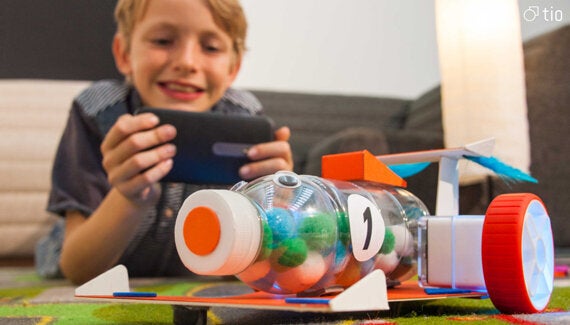
Not so long ago, I was a student at the Royal College of Art and Imperial College London finishing my masters in Innovation Design Engineering. I could have gone for a corporate job but my goal was different. I wanted to find the right idea with the potential to become a business with social impact. In my final year, I discovered my mission and came up with the idea. The mission was to inspire tomorrow's inventors by creating a product that fuses craft and tech, the feeling of creating with your hands and the power of today's technology. The idea was an invention kit to build app-controlled toys and inventions in seconds. I wanted to make it so easy that kids of all ages could effortlessly animate and program the world around them. It sounded fun, exciting and definitely challenging. That was the beginning of my journey but how did I transform a student's idea into a business? How did I go from my solo project to becoming one of three passionate co-founders?
Initially I worked on my idea while at University. I created a prototype which wasn't perfect and wouldn't work 100% of the time. What I knew is that everyone who saw and played with it thought it was cool, different and exciting. That initial feedback was a huge driver for me. Upon graduation, I realised I had only just scratched the surface of what was possible. It was time to create the dream toy for kids. But how to go about it?
Step one was to find the perfect founding team. I knew I couldn't do it on my own so I set out to build a team with a wide range of skills. Fortunately, during my course, I had the pleasure of working with a diverse group of talented people. I first worked with Ashley Wiltshire on the bizarre task of designing an Apple Flyswatter (a branding lesson). To our surprise, our complete opposite skillset and contrasting thinking resulted in a fun and productive partnership. Ashley introduced me to Mario Morello, a talented marketing professional, and suddenly we had a founding team.
Step two was incorporating the business and agreeing on what we stood for. We decided to call the business Tio, the anagram of Internet of Things (IoT) and also the Spanish slang word for friend. We think we did a good job with choosing a name for the business but I guess the jury is out on that and only time will tell whether it will become a household name.
Step three was finding a support structure which could enable Tio to grow and attract funding. For us that was InnovationRCA, the incubator of the Royal College of Art in the James Dyson Building. Before we knew it, we had an office, access to mentors and funding.
The next step was to refine the prototype, keep testing and ultimately have a manufacture ready product to launch. From day one we focused on creating not just a new product but a unique new way of inventing, playing and learning. To create a compelling experience we knew it was key to continuously listen to our users' feedback. Working with hundreds of 6-12 year olds, their parents and teachers, we discovered two key learnings. Children want to build toys that are unique to them and set them apart from others. They see physical and digital as an extension of the same world and expect their experience to seamlessly continue from one medium to the other without the friction and limitation of current products. On the other hand, parents and teachers want children to development cognitive and physical skills whilst having fun. These two key learnings made us feel we were onto something, something that could encourage creativity and long term play. We had a mission and we were starting to see how to fulfil it.

To do that we delved into prototyping. Prototypes started with dummy wooden blocks and toy wheels. This process gave us an immediate insight into the ideal scale and form for the hardware. We asked children to imagine their dream building block's features and to make cardboard mock-ups of the toys and inventions they would love to create. By acting out scenarios in which they controlled and programmed their models from a smartphone, we gained the first ideas and framework for the app that brings it all to life.
These early interactions helped us to evolve our design through a number of 3D printed iterations and beta apps and brought us to where we are today. We now have a founding team, a business, a product and as of last week one more competition win under our belt, namely the Nacue Varsity Pitch. I never thought it was going to be easy but step after step, I am more motivated than ever to fulfil my passion and build the dream toy for children.